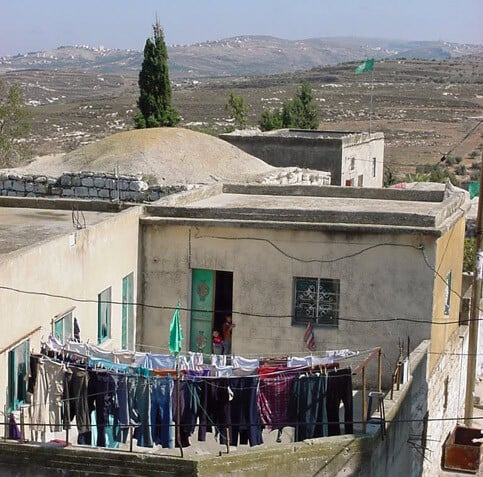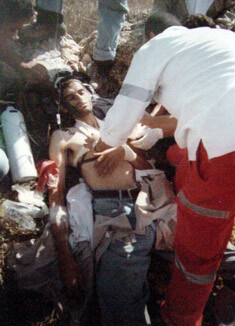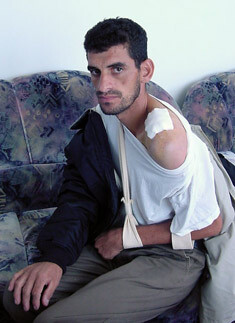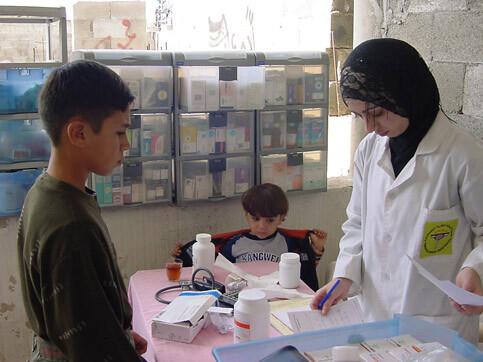Tulkarem and Qalqilya 3 November 2006

View from a rooftop in Farata village
30 October 2006: In the villages of Far’ata, and Imateen, East of Qalqilya in the occupied West Bank
Our mobile health van, sponsored by Palestinian Medical Relief Society, climbs steep switchbacks through narrow alleyways to the top of the hill. We arrive at the town meeting hall in the village of Far’ata (population 700) and start unpacking our boxes of pharmaceuticals and other equipment. It is here that we set up our makeshift clinic and start seeing patients.
Graffiti supporting Hamas fills the walls of the village, and green flags with Islamic inscriptions fly from the roof of the mosque. The meeting hall itself sports a poster supporting Fateh, the party of Mahmoud Abbas (Abu Mazen) and the late Yasser Arafat.

Dr. ‘Azzam Faez and Dr. Osama Salami getting ready to work in Farata village for Palestine Medical Relief Society (PMRS) mobile health care unit
I am working with Dr. ‘Azzam Faez, an obstetrician-gynecologist who was trained in Romania and Dr. Osama Salami, a pediatrician who was trained in the Ukraine. I introduce myself to them as “Dr. Bill.” Dr. Osama says, “Ahh … Bill Clinton?”, and I respond, “Of course! And you are Osama Bin-Laden?” We laugh, and then get to work. The loud speaker from the minaret above the mosque announces that there are clinic services in the village today, and patients start showing up.
It is the usual primary care stuff: common colds, ear infections, urinary tract infections, gastroenteritis, arthritis and the like. We treat based on the patients’ history and on physical exam. Lab services are not immediately available, other than blood sugar. If we really need them, we write a script and send the patient to a lab in a larger town. PMRS plans to add lab technicians to the mobile health team soon so that routine tests like urinalysis, pregnancy test, and rapid streptococcal analysis can be done on the spot while we wait; other lab samples can by obtained from patients in the villages and taken to the lab in Qalqilya for analysis and then reported to the patient during the next visit to their village.

Basel Ibrahim Mahmood Salah immediately after being attacked by settlers in an olive grove near the village of Farata and the settlement of Gilad on 25 October 2006

Basel during our visit in 30 October 2006
At the end of the session, we pay a house call at the home of Basel Ibrahim Mahmood Salah, who was assaulted by Israeli settlers five days ago while trying to harvest his olive trees. His testimony, which is translated into English through the help of Dr. Osama, follows:
On 25 October 2006, we were picking olives from our trees. An IOF Hummer drove up, and we were warned that we were standing too close to the settlement. Two settlers rode up on horses and then tuned around, waiting for the Hummer to leave. One hour later, about 50 settlers from the new squatter settlement of Gilad approached. They started firing their weapons into the air and then throwing stones at us. We men held our ground, while our wives and children fled. During the ensuing standoff, we called the occupation authorities from our mobile phone and asked them to come and stop the aggression. Two IOF soldiers arrived one hour after the call and did nothing. Most of the settlers dispersed, but seven remained. They attacked us with metal rods. I was struck in the head and left shoulder. I was taken to Meyer Hospital (an Israeli hospital in the area). X-rays showed I had a fracture in the left shoulder. In all, four of us were injured in this way.After we finish in this village, our mobile health unit van moves to another village called Imateen (two mothers), and we see more patients. We are served Arabic coffee and tea by the villagers. We are fed lunch at the end of the clinic session. We then head back to Qalqilya past several Israeli settlements and through two Israeli checkpoints to get into the town. Qalqilya, a town of 60,000 inhabitants, is completely surrounded by the annexation barrier and there is only one major exit and entrance through a checkpoint that can be cut off at a moment’s notice. Towns are being enclaved by this annexation barrier all over the West Bank: the Ghettoization of Palestine.
We pass a third checkpoint to get to Tulkarem, (population about 100,000) where I am now staying. From my window I can see the barrier, which is a wall here. This is one of the few places where the wall actually runs along the green line, the actual border between the West Bank and Israel. The reason for this is that Tulkarem is densely populated.
In rural areas, the barrier is wider, consisting of trenches, electric fences and motion detectors. It weaves in and out of the West Bank encircling settlements and placing them on the Israeli side. Near Qalqilya, it steals the best water aquifers in the West Bank. The strategy behind the annexation barrier’s convoluted route is to steal as much land and natural resources as possible, while excluding as many Palestinian people as possible.

PMRS portable makeshift pharmacy
31 October 2006: In the Villages of ‘Ilar and Saida, North of Tulkarem
These villages are right next to each other. Our routine is similar to what we did yesterday. In Saida, I am told that this village has a population of 3,500 people. Since the current intifada, which started in September 2000, 24 villagers have been killed, and 60 have been imprisoned by the Israeli Occupation Forces.
Dr. Osama explains that the occupation affects all aspects of life in more intangible ways. In his own case, he is now 32 years old. During his primary school days, he was a model student, scoring 86.7 percent on his graduation exams. Now the Palestinians have a medical school in Abu Dis at Al Quds University, just east of Jerusalem, and one under development in Gaza. But in those days, there was no medical school in Palestine, so Osama Salami was forced to study abroad.
He could have gone to medical school in Syria or Iraq where he would have been able to study for free. Unfortunately, travel to these countries would mean that he would most likely be arrested by the Israelis upon his return, since Palestinians from the Occupied Territories are forbidden to travel to these countries. So instead, he opted to receive his medical education in the Ukraine. He invested $60 thousand and spent one year learning the Russian language, because medical studies are taught in Russian in the Ukraine. He then spent six years in medical school and then five more years doing his residency in pediatrics.
Upon return to Palestine, he found that jobs are hard to come by. His present job with the medical relief society pays about $650 per month. He is engaged to be married, but must wait because he still cannot afford a wedding.
After a day seeing patients, we return to Tulkarem and I have a rest. At 7 pm I am met by Dr. Imad Barakah, the Director Manager of the Qalqilya District of Palestine Medical Relief Society. We walk to his house, the same house where he was born 45 years ago. It is the house of his parents and grandparents before him. Dr. Imad points to the sky and says, “Look!” An Israeli spy plane is flying slowly overhead, back and forth, over the skies of Tulkarem. “That means there will be a military incursion here tonight. They can listen to our mobile phone conversations, because they are looking for someone that they want to arrest.”
After a pleasant evening at his home, we do a house-call and visit an elderly gentleman with diabetes who had surgery following a femur fracture which was caused by a fall. The surgery was complicated by a soft tissue infection, which is now improving. We walk back to where I am staying. Dr. Imad warns me that “If there are Israeli Armored Personnel Vehicles (APVs) in the street, turn out all the lights, and keep your distance from the window or you could be shot.” I am getting surprisingly used to all this insanity — I am able to fall asleep without any problem!
Dr. Bill Dienst is a rural family and emergency room physician from Omak, Washington, USA





